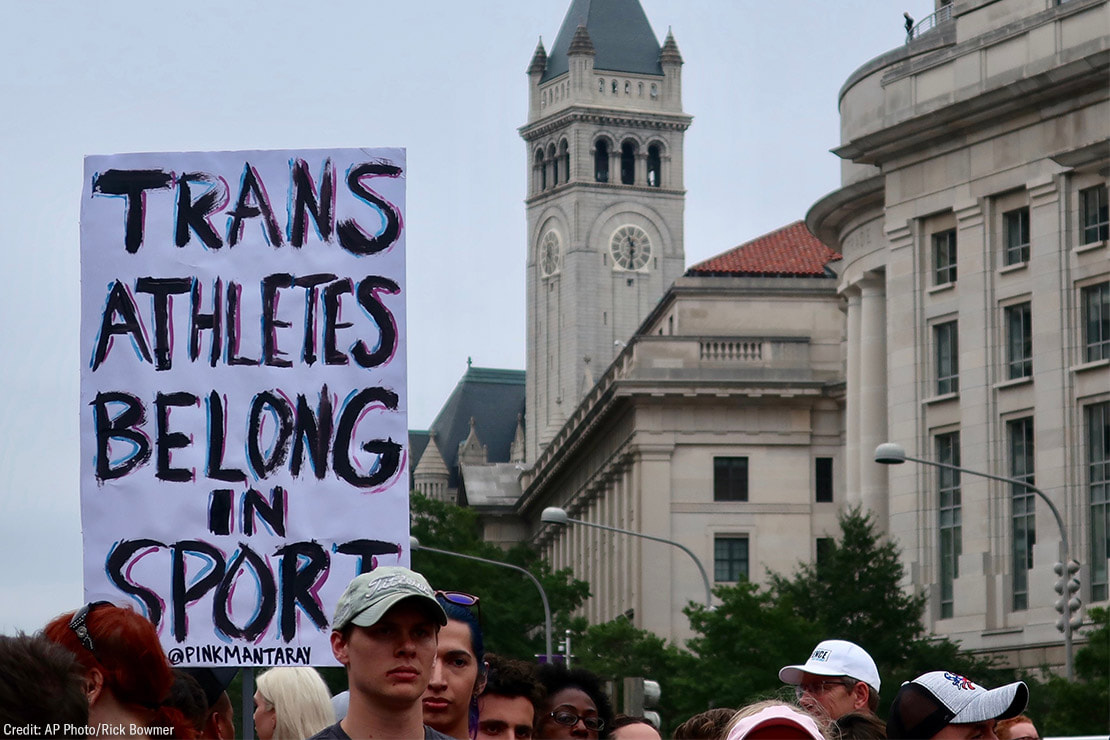"...a series of bills have been presented to restrict trans athletes and youth from participating in sports which could have disastrous affects on peoples mental health and violates what should be considered human rights. "
-- Jadyn Polk

Trigger Warning: mentions of depression and suicide
In 2022, state legislation saw 240 bills aimed at transgender Americans, which is nearly double the number of bills from 2021, a new record. Some of these bills, having passed over from 2021, are on the precipice of becoming certified state laws. These bills cover restrictions on everything from prohibiting classroom discussion about sexual orientation to bathroom access, health care, and sports. In particular a series of bills have been presented to restrict trans athletes and youth from participating in sports which could have disastrous affects on peoples mental health and violates what should be considered human rights.
With the Olympics just passing, conversations have emerged around what role gender plays in sports, and where people should go. Looking at professional level sports such as the Olympics, the conversation on how to categorize athletes is continuous. Methods such as testing testosterone, chromosome, or invasive body examinations repeatedly fail because humans of either sex don’t always fit into the same categories. Regardless of sex, our bodies aren’t one size fits all. In a case against athlete Dutee Chand, a female sprinter banned due to her high testosterone levels, it sparked the conversation around testosterone's effects on players. According to Maayan Sudai from the Harvard Law division “..the evidence brought by the IAAF to support the link between testosterone levels and athletic performance referred only to exogenous testosterone (externally consumed), and not endogenous testosterone (naturally produced).” There was no evidence or case backed by natural testosterone being a telltale sign for competitive ability. However, both parties agreed that lean body mass (LBM) affects athletic performance. This can differentiate between the male and female sexes, but males usually have a higher LBM than females. To provide further information, under estrogen treatment, within twelve months there is a significant decrease in LBM. As with testosterone treatment there is a an significantincrease in LBM after just three months.
Unfortunately, we can see a lot of these opinions coming to fruition as fifty of the new bills target banning trans youth from playing sports. Idaho in 2020 was the first state to place a ban on trans people participating in sports from kindergarten through college. So far, ten states in total have bans against trans students playing sports in schools. Bill SB 9 is one such bills, stating that “No athletic team or sport designated for females, women, or girls shall be open to students of the male sex, as assigned at birth.” This bill, along with many others of various titles such as House Bill 25, aim to establish the Save Women’s Sports Act,which is in support of banning “males” from “female” sports. According to Beth Stelzer, advisor for the Save Women’s Sports Act, “"If we allow males to compete in female sports; there will be men's sports, there will be co-ed sports, but there will no longer be women's sport.”. As stated by a major supporter of the bill, Texas state representative Valoree Swanson, “House Bill 25 is one of the greatest victories for equality for girls since Title IX passed 50 years ago!” These bills supposedly have the intention of supporting equality when the argument for why it is equitable isn’t based in fact. Feminism isn’t feminism if you can only support some women by oppressing others.
With the information provided above it can be concluded that athletes should probably be divided by LBM rather than sex or testosterone levels if the argument is to keep competition fair and to protect all players. Since all of that is public information, these bills being passed show how much our political officials truly care about keeping games fair and what their priorities are when it comes to passing bills. This country has a long standing reputation for solving problems with quick fixes that ends up oppressing groups who are already struggling.
If laws like these are allowed to pass you will only see a further increase in depression and suicide rates among trans children, who already have the highest suicide rates among youth. Accordling to Rina Torchinsky of NPR “Between 2020 and 2021, the Trevor Project saw a 150% increase in crisis contacts from LGBTQ youth in Texas seeking support.” The Trevor Project reports that the increase is coming from youth who are stressed and depressed about what these bills could mean for them. Who are these laws trying to protect?
America claims to be a country of opportunity and rights, but yet again we are being faced with hypocrisy that denies even the simplest pleasure of playing sports.
While allowing trans children to play sports won’t single-handedly fix the mental effects that discrimination has on trans youth, it can help prevent furthr damage. There is so much information on all the physical and mental health benefits that come with playing sports; excluding children from them could potentially damage already vulnerable youth. It’s not a risk that anyone should be willing to make.
Trigger Warning: mentions of depression and suicide
In 2022, state legislation saw 240 bills aimed at transgender Americans, which is nearly double the number of bills from 2021, a new record. Some of these bills, having passed over from 2021, are on the precipice of becoming certified state laws. These bills cover restrictions on everything from prohibiting classroom discussion about sexual orientation to bathroom access, health care, and sports. In particular a series of bills have been presented to restrict trans athletes and youth from participating in sports which could have disastrous affects on peoples mental health and violates what should be considered human rights.
With the Olympics just passing, conversations have emerged around what role gender plays in sports, and where people should go. Looking at professional level sports such as the Olympics, the conversation on how to categorize athletes is continuous. Methods such as testing testosterone, chromosome, or invasive body examinations repeatedly fail because humans of either sex don’t always fit into the same categories. Regardless of sex, our bodies aren’t one size fits all. In a case against athlete Dutee Chand, a female sprinter banned due to her high testosterone levels, it sparked the conversation around testosterone's effects on players. According to Maayan Sudai from the Harvard Law division “..the evidence brought by the IAAF to support the link between testosterone levels and athletic performance referred only to exogenous testosterone (externally consumed), and not endogenous testosterone (naturally produced).” There was no evidence or case backed by natural testosterone being a telltale sign for competitive ability. However, both parties agreed that lean body mass (LBM) affects athletic performance. This can differentiate between the male and female sexes, but males usually have a higher LBM than females. To provide further information, under estrogen treatment, within twelve months there is a significant decrease in LBM. As with testosterone treatment there is a an significantincrease in LBM after just three months.
Unfortunately, we can see a lot of these opinions coming to fruition as fifty of the new bills target banning trans youth from playing sports. Idaho in 2020 was the first state to place a ban on trans people participating in sports from kindergarten through college. So far, ten states in total have bans against trans students playing sports in schools. Bill SB 9 is one such bills, stating that “No athletic team or sport designated for females, women, or girls shall be open to students of the male sex, as assigned at birth.” This bill, along with many others of various titles such as House Bill 25, aim to establish the Save Women’s Sports Act,which is in support of banning “males” from “female” sports. According to Beth Stelzer, advisor for the Save Women’s Sports Act, “"If we allow males to compete in female sports; there will be men's sports, there will be co-ed sports, but there will no longer be women's sport.”. As stated by a major supporter of the bill, Texas state representative Valoree Swanson, “House Bill 25 is one of the greatest victories for equality for girls since Title IX passed 50 years ago!” These bills supposedly have the intention of supporting equality when the argument for why it is equitable isn’t based in fact. Feminism isn’t feminism if you can only support some women by oppressing others.
With the information provided above it can be concluded that athletes should probably be divided by LBM rather than sex or testosterone levels if the argument is to keep competition fair and to protect all players. Since all of that is public information, these bills being passed show how much our political officials truly care about keeping games fair and what their priorities are when it comes to passing bills. This country has a long standing reputation for solving problems with quick fixes that ends up oppressing groups who are already struggling.
If laws like these are allowed to pass you will only see a further increase in depression and suicide rates among trans children, who already have the highest suicide rates among youth. Accordling to Rina Torchinsky of NPR “Between 2020 and 2021, the Trevor Project saw a 150% increase in crisis contacts from LGBTQ youth in Texas seeking support.” The Trevor Project reports that the increase is coming from youth who are stressed and depressed about what these bills could mean for them. Who are these laws trying to protect?
America claims to be a country of opportunity and rights, but yet again we are being faced with hypocrisy that denies even the simplest pleasure of playing sports.
While allowing trans children to play sports won’t single-handedly fix the mental effects that discrimination has on trans youth, it can help prevent furthr damage. There is so much information on all the physical and mental health benefits that come with playing sports; excluding children from them could potentially damage already vulnerable youth. It’s not a risk that anyone should be willing to make.


